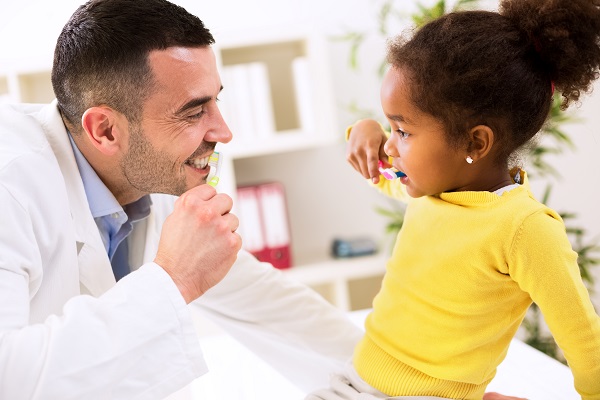Parents, take a good look in the mirror. How are your teeth these days?
If you’ve ever wished that your mom and dad had taught you better dental hygiene habits, now’s your chance to pay it forward—to your own kids.
By teaching good habits even before your child has teeth—right from the start—and continuing to emphasize the importance of oral health throughout childhood, you can help your children grow up with a great, white smile; straight, strong teeth; and a healthy mouth.
An Age-by-Age Guide to Toothbrushing
Don’t want to hear the complaints? Here’s an age-by-age guide to get your kids brushing, according to the American Academy of Pediatrics:
Birth to first tooth
As soon as your baby is born, you can begin wiping your baby’s gums with a soft, damp washcloth after feedings. While it’s not really necessary, it’s a great way to get your baby used to the idea of “brushing.”
First tooth to under age 3
When that toothless grin starts showing signs of a pearly white, switch to a toothbrush. Choose a baby toothbrush, typically made of soft silicone with barely there “bristles.” Add just a dab—no larger than a grain of rice—of fluoride toothpaste and brush those little teeth in the morning and at night. There’s no need to rinse.
Once you start solids, make as many healthy choices as you can to help avoid the risk of tooth decay. Plus, undiluted juice and sugary sweets are as bad for your child’s physical health as they are for your child’s oral health. And don’t follow grandma’s suggestion of putting baby to bed with a bottle—the prolonged exposure to sugars in the milk or formula can lead to decay, especially in the front teeth.
If your toddler refuses to allow the toothbrush in his or her mouth, don’t force it. Instead, make it fun! Toddlers love to copy their parents, so show your baby how you brush your teeth and then brush theirs. You can also play “toothbrushing” with favorite dolls and stuffed animals. Distractions like singing and playing with a toy can also help. Also try brushing without toothpaste or a different flavor of toothpaste.
The American Academy of Pediatric Dentistry encourages parents and other care providers to establish a dental home for every child by 12 months of age. A dental home should provide:
- comprehensive oral health care, including acute care and prevention;
- cavities risk assessment;
- periodontal risk assessment;
- anticipatory guidance regarding growth and development;
- a plan for acute dental trauma;
- dietary counseling;
- referral to dental specialists when care cannot be provided within the dental home.
Ages 3 to 6
Your child is now old enough to use a pea-sized amount of fluoride toothpaste, twice a day. There is no need to rinse after brushing since rinsing will dilute the amount of fluoride deposited on the teeth during brushing.
Now’s also the time to upgrade to a toddler toothbrush, preferably one with a thicker handle that’s easier to grasp. It can help—if your child will let you—to hold your hand over theirs as they are learning to brush their own teeth. Children at this age will likely demand to brush teeth on their own. But proudly check out their work afterwards—and add a few touchups if needed. The goal now is to have children brush their teeth for two minutes—singing, music and a timer can all help.
Your child of course may still resist toothbrushing. Here are a few tricks that can help:
- Start a brushing calendar. Hang it in your child’s room, and put a sticker on the calendar every day that they brush their teeth.
- Don’t limit brushing to the bathroom. While brushing should be part of your regular routine, if your child is sick or had a tough day, there’s no harm in bringing the toothbrush to bed and having them brush their teeth right there. Just have a paper towel handy for them to spit out the excess toothpaste. Ditto in the mornings if you’re running late for daycare or school—have them brush their teeth in the car.
- Let them choose. A toothbrush with a beloved character and a toothpaste in a favorite flavor can go a long way in encouraging kids to brush—and brush often!
Ages 6 to 12
Goodbye baby teeth, hello permanent teeth! Your child may start losing baby teeth as early as age 5 and through age 7.
Because teeth are now permanent, it’s even more important to have good toothbrushing—and now flossing—habits. Flossers—individual flossing devices with easy-grip handles (bonus: they’re available in lots of fun colors!)—are easier to use than floss in the beginning. Children can also now upgrade to no more than a 1-inch strip of toothpaste. Make sure kids spit now too since more toothpaste is being used.
With so many changes in your child’s mouth at this point, your every-six-month dental visit is also more important than ever. Your pediatric dentist can monitor your child’s teeth to watch for abnormal bites or crooked or misplaced teeth. He or she might also recommend dental sealants to help prevent cavities in hard-to-reach back teeth.
If your child is into contact sports, a mouthguard is a good idea to protect those precious permanent teeth. Talk to your dentist about the best type for your child.
Ages 13 and up
Remember when you had to chase your toddler around to brush his or her teeth? Sometimes you may feel the same way with your teen.
But good dental hygiene habits are even more important now, especially if teens are dealing with braces, snacking on sweets or playing sports—or if they like to meet up with friends at Starbucks or choose to use tobacco.
Your teen might not want to take the time to brush and floss twice a day, but try emphasizing the positive aspects of taking those four minutes: fresh breath for any significant others and the overall attractiveness of a whiter smile. Or, when they’re old (like you), less risk of root canals or more extensive procedures—or scary thought: dentures!—down the road.




